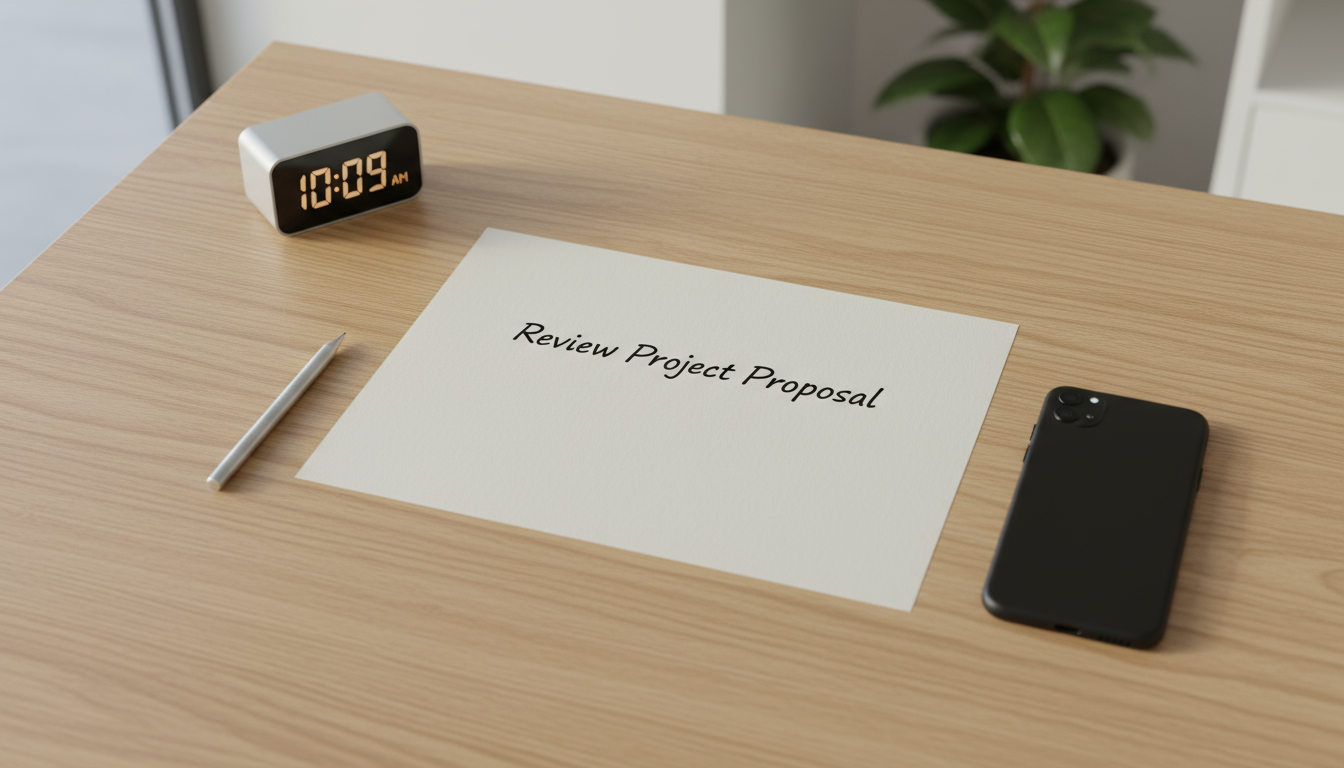
Do you ever feel like your brain is a browser with too many tabs open? A constant hum of notifications, reminders, and a to-do list that never seems to shrink. You sit down to work on something important, but your attention splinters. A quick email check turns into twenty minutes of inbox triage. A simple question leads you down a rabbit hole of web searches. This is mental friction. It’s the feeling of pushing against a current of distraction, and it is exhausting.
But what if there was another way? What if you could access a state of mind where that friction melts away? A state where you are so absorbed in your work that the world around you fades. Time seems to warp. Your skills feel perfectly matched to the challenge in front of you. This isn’t a fantasy. This is the flow state. It’s the sweet spot of peak performance and deep enjoyment, and it is accessible to you.
For many, achieving this level of deep focus feels like a matter of luck. A rare, magical alignment of the stars. The truth is much more encouraging. Getting into a state of flow is a skill. It’s a muscle you can train. It doesn’t require superhuman willpower. It requires intention, practice, and a set of practical rituals that prime your mind for deep work.
This guide will show you how. We will demystify the science of attention and provide you with a clear, step-by-step framework to cultivate more flow in your life. Forget the guilt and the frustration. Let’s build a system that helps you reclaim your focus, reduce overwhelm, and find genuine satisfaction in your work. You are capable of incredible concentration. Let’s unlock it together.
📚 Table of Contents
- What Is Flow State, Really? Understanding Your Attention
- The Problem of Cognitive Load
- The High Cost of Context Switching
- The Power of Monotasking and Energy Rhythms
- The Four Essential Rituals for Deep Work and Flow
- 1. The Startup Ritual: Priming Your Brain for Focus
- 2. The Deep Work Entry Ritual: Crossing the Threshold into Flow
- 3. Break Hygiene: How to Recharge, Not Deplete
- 4. The Shutdown Ritual: Ending Your Day with Clarity
- Your 15-Minute “Flow State” Starter Pack
- Powerful Thought Tools to Cultivate Concentration
- Reframe Perfectionism: “Good Enough” is Your Ally
- Reduce Friction: Make Focus the Easiest Choice
- Script Your Reset: What to Do When You Get Derailed
- Flow State in Action: Two Real-World Scenarios
- Frequently Asked Questions About Achieving Flow
- Does music or white noise help or hurt concentration?
- I thought multitasking was a good thing. Is it always bad?
- What do I do when my motivation completely disappears?
- Can I achieve a flow state in the evening after a long day?
- How long does it take to get into a flow state?
- Your 7-Day Challenge: Start Building Your Focus Muscle

What Is Flow State, Really? Understanding Your Attention
Before we learn how to get into flow state, we need to understand exactly what it is and how our attention works in the modern world. The term was coined by psychologist Mihaly Csikszentmihalyi, who studied top performers across many fields, from artists to athletes to scientists. He found a common thread in their descriptions of peak experience.
Flow state is a cognitive state of optimal experience where a person is fully immersed in an activity with energized focus, full involvement, and enjoyment. You might know it as being “in the zone.” When you’re in flow, your sense of self-consciousness disappears. You’re not worried about what others think or second-guessing your every move. Time either speeds up or slows down. Your actions and awareness merge, creating a feeling of effortless control and deep engagement.
This state isn’t just for creative geniuses or elite athletes. It’s a fundamental human experience. You’ve likely felt it when lost in a good book, engrossed in a hobby, or having a deep conversation with a friend. The key is that the conditions were right. Our goal is to create those conditions on purpose, especially for our most important work.
To do that, we first need to acknowledge the enemy of flow: our modern digital environment. Our brains evolved for a very different world. They did not evolve to handle the constant barrage of information, notifications, and demands for our attention. This leads to a few common problems that actively block flow.

The Problem of Cognitive Load
Think of your working memory as a small table. You can only place a few items on it at once before things start to fall off. Cognitive load is the total amount of mental effort being used at any given moment. When you try to check email, listen to a meeting, and think about your next project all at the same time, you’re overloading that table. Your brain can’t process it all effectively. The result is stress, mistakes, and the feeling of being completely overwhelmed. Flow requires a low cognitive load, where your mental resources are dedicated to a single, primary task.

The High Cost of Context Switching
Many of us believe we are good at multitasking. The science, however, is clear. Our brains don’t actually multitask on complex tasks. Instead, they perform rapid context switching. This is the act of stopping one task to quickly do another, then another, then switching back. Each switch comes with a cognitive cost. It takes time and mental energy to disengage from the first task and load the context for the second. According to research referenced by organizations like the American Psychological Association, these constant micro-interruptions can reduce productivity by as much as 40%. It’s like revving a car’s engine in neutral; you burn a lot of fuel without going anywhere. Context switching is the direct opposite of the sustained focus required for deep work.

The Power of Monotasking and Energy Rhythms
The solution is simple, though not always easy: monotasking. This means focusing on one single task at a time. It is the foundational practice for entering a flow state. By dedicating your full attention to one thing, you allow your brain to go deep, make connections, and perform at its best.
This works in harmony with your body’s natural energy cycles, known as ultradian rhythms. Throughout the day, your brain moves through cycles of high and low energy, typically lasting about 90 to 120 minutes. You can’t maintain peak concentration for eight hours straight. The goal is not to fight this but to work with it. We can use focused, 60- to 90-minute sprints of deep work, followed by periods of genuine rest, to align with these natural rhythms. This is how you build a sustainable focus practice that prevents burnout and makes flow a regular part of your day.

The Four Essential Rituals for Deep Work and Flow
If you rely on willpower alone to find focus, you will lose. Willpower is a finite resource that gets depleted by decision-making, emotional regulation, and resisting temptation. Rituals are the answer. A ritual is a sequence of actions you perform consistently. It automates the process of getting started, saving your precious mental energy for the work itself. By building these four rituals into your day, you create a powerful system that signals to your brain it’s time for deep work.

1. The Startup Ritual: Priming Your Brain for Focus
The way you begin your workday, or any focused session, sets the tone for everything that follows. A Startup Ritual is a short, consistent routine that transitions you from a state of distraction to a state of readiness. It’s like a warm-up for your mind. Its purpose is to clear away the clutter, both external and internal, so you can begin with clarity.
Your ritual can be simple. It might involve tidying your physical desk, closing all unnecessary browser tabs and applications, and turning off phone notifications. Pour a glass of water or a cup of tea. Then, take one minute to look at your plan for the day and identify the single most important task for your upcoming focus session. Write that one task on a sticky note and place it in front of you. This act of naming your intention is incredibly powerful. It tells your brain exactly what to focus on and what to ignore. You are drawing a line in the sand and declaring, “This is what matters now.”

2. The Deep Work Entry Ritual: Crossing the Threshold into Flow
The hardest part of any focused work session is the first 15 minutes. This is when your brain is most likely to resist. It craves the easy dopamine hit of distraction. An Entry Ritual helps you push through this initial friction. The goal is to make starting so easy that you can’t say no.
One of the most effective techniques is to use a timer. The Pomodoro Technique is a great example: you set a timer for 25 minutes and commit to working on your chosen task without interruption until it rings. But even 25 minutes can feel intimidating. So, start smaller. Set a timer for just 10 or 15 minutes. Tell yourself, “Anyone can focus for 10 minutes.” Give yourself permission to stop when the timer goes off. More often than not, you’ll find that by the time the timer rings, you’ve overcome the initial resistance and built enough momentum to keep going. You’ve crossed the threshold and are on your way to a flow state.

3. Break Hygiene: How to Recharge, Not Deplete
Breaks are not a sign of weakness; they are a biological necessity for high-quality work. However, not all breaks are created equal. Poor break hygiene can leave you feeling more tired and distracted than when you started. A “bad” break is one that introduces more cognitive load. This includes scrolling through social media, reading the news, or checking your email inbox. These activities flood your brain with new information and context, preventing it from truly resting.
Good break hygiene involves activities that allow your prefrontal cortex—the part of your brain responsible for executive function—to relax. Get up from your desk. Stretch your body. Look out a window at something distant to relax your eyes. Get a glass of water. Do a few simple breathing exercises. Let your mind wander. These short, restorative breaks, taken every 60-90 minutes, are what allow you to return to your work with renewed energy and concentration.

4. The Shutdown Ritual: Ending Your Day with Clarity
How you end your day is just as important as how you begin it. Without a clear end, work can bleed into your personal time, creating a persistent, low-level anxiety. This is due to a psychological phenomenon called the Zeigarnik effect: our brains are wired to remember unfinished tasks more than completed ones. A Shutdown Ritual helps to counter this by creating a sense of closure.
At the end of your workday, take five minutes to review what you’ve accomplished. Acknowledge your progress. Then, quickly plan your most important tasks for the next day. This transfers your plans from your head onto paper (or a digital system), signaling to your brain that it can let go. Finally, tidy your workspace and say a specific phrase to yourself, like “Shutdown complete.” This simple act creates a firm boundary between work and rest, allowing you to truly disconnect and recharge, which is essential for achieving flow the next day.

Your 15-Minute “Flow State” Starter Pack
Feeling overwhelmed by all this? Let’s make it incredibly simple. Here is a 15-minute routine you can try today to get a taste of focused work.
Minutes 1-2 (Startup): Close every browser tab that isn’t related to your immediate task. Put your phone on silent and place it face down, out of reach. Write your one task on a piece of paper.
Minutes 3-13 (Entry): Set a timer for 10 minutes. For these 10 minutes, commit to working *only* on that single task. If your mind wanders, gently guide it back. Remind yourself it’s just for 10 minutes.
Minutes 14-15 (Break/Shutdown): When the timer rings, stop. Stand up and stretch. Take a sip of water. Ask yourself: “Do I have the energy to go for another 10 minutes?” If yes, reset the timer. If no, you’re done. Close the document and acknowledge that you successfully practiced focusing. This small win builds the foundation for longer periods of deep work.

Powerful Thought Tools to Cultivate Concentration
Building a system of rituals is the external framework for focus. But the internal work—the way you think about your work and yourself—is just as crucial. Your mindset can either create the friction that blocks flow or pave a smooth path toward it. Here are three powerful thought tools to help you manage your internal state and make concentration feel more natural.

Reframe Perfectionism: “Good Enough” is Your Ally
Perfectionism is one of the greatest enemies of flow. It masquerades as a desire for high quality, but it is often rooted in fear: fear of judgment, fear of failure, fear of not being good enough. This fear creates enormous pressure and makes the simple act of starting feel monumental. When the stakes feel that high, your brain will seek the safety of procrastination and distraction.
The reframe is to embrace the concept of “good enough for now.” Give yourself permission to produce a messy first draft. Author Anne Lamott famously calls this the “shitty first draft.” The goal is not to create a masterpiece from the very beginning. The goal is simply to begin. You can always edit, revise, and improve later. Flow happens when you are in the process of creating, not when you are frozen by the judgment of the outcome. By lowering the stakes and focusing on progress over perfection, you release the brake on your mind and allow momentum to build.

Reduce Friction: Make Focus the Easiest Choice
Our brains are wired to conserve energy. They will naturally drift toward the path of least resistance. If checking your phone is easier than opening your work document, distraction will win almost every time. The key is to strategically engineer your environment so that focus becomes the easiest and most obvious choice.
This is about reducing the friction associated with starting your work and increasing the friction associated with distraction. Make focus easier by preparing your tools in advance. Before you end your day, open the exact document or application you’ll need for your most important task tomorrow. Make distractions harder. Don’t just put your phone on silent; put it in another room. Use a website blocking app to make it impossible to access your go-to distraction sites during your focus blocks. Every small barrier you put between yourself and a distraction makes it less likely you’ll choose it. You are designing your environment to support your intentions, making deep work the default option.

Script Your Reset: What to Do When You Get Derailed
No matter how perfect your system is, you will get distracted. A family member will interrupt you. A sudden, urgent thought will pop into your head. Your mind will wander. This is not a failure; it is a normal part of being human. The real damage is not in the initial distraction but in the reaction that follows. Many of us fall into a shame spiral. We get angry at ourselves for losing focus, which creates more negative emotion and makes it even harder to get back on track.
The solution is to have a pre-planned, non-judgmental reset script. It’s a simple, calm phrase you can use to gently guide your attention back to your task. Your script could be something like: “Okay, my mind wandered. That’s normal. Let’s take one deep breath and return to the task.” Or simply, “Thinking. Back to work.” The key is the tone. It should be compassionate and neutral, like a pilot correcting the course of a plane. By having this script ready, you avoid the downward spiral of self-criticism and dramatically shorten the time it takes to recover from a distraction, preserving your momentum toward a flow state.

Flow State in Action: Two Real-World Scenarios
Theory is helpful, but seeing these principles applied to real-life challenges makes them tangible. Let’s explore how to use these focus rituals and thought tools in two common, difficult situations. The goal is not to achieve a perfect, unbroken flow state, but to navigate these challenges with more intention and less stress.

Scenario 1: The Tight Deadline
The Problem: You have a major project due in 48 hours. The pressure is immense, and your mind is racing. You feel a sense of panic and overwhelm, which makes it impossible to even know where to start. Your brain is jumping from one worry to another, and you find yourself procrastinating with “easy” but unimportant tasks.
The Flow-Based Solution:
First, you must calm the storm. The feeling of overwhelm comes from looking at the entire mountain at once. Your immediate goal is to shrink your focus to the very next step.
1. Use the Startup Ritual to Ground Yourself: Take three minutes. Close every single tab except what you need for this project. Put your phone in a drawer. Take ten slow, deep breaths. Write down the absolute, smallest, first physical action you need to take. Not “write the report,” but “open a new document and write a single headline.”
2. Employ an Entry Ritual with a Timer: The pressure makes it hard to commit to hours of work. So don’t. Set a timer for 25 minutes. Commit to working *only* on that tiny first step for just 25 minutes. This creates a container for your panic. You are not trying to finish the project; you are just trying to survive and make a tiny bit of progress for 25 minutes.
3. Practice Strict Break Hygiene: When the timer rings, you must take a 5-minute break. Do not check email or the news. Stand up. Walk to the kitchen and get a glass of water. Look out the window. Do not think about the project. This gives your brain a real pause.
4. Repeat the Cycle: After the break, set the timer again. Identify the next smallest step and repeat the process. By breaking the overwhelming project into a series of small, timed sprints, you replace panic with a rhythm of focused action. This is how to get into flow state when the pressure is on. You build momentum, and soon, you’ll find yourself absorbed in the work rather than the worry.

Scenario 2: The Noisy Home Environment
The Problem: You work from home, and your environment is filled with unpredictable interruptions. Kids, pets, a partner on a loud conference call, the doorbell ringing. It feels impossible to find a quiet block of time to achieve the deep concentration needed for complex tasks.
The Flow-Based Solution:
In this scenario, you cannot control the entire environment, so you must focus intensely on what you *can* control. This is about creating a “focus bubble” amidst the chaos.
1. Proactive Communication (Part of Your Startup): Before you begin a focus block, communicate your needs. Say to your family or roommates, “I am starting a 60-minute focus session. Please only interrupt me if it’s a true emergency.” This sets a boundary and manages expectations.
2. Engineer Your Sensory Input: Invest in a good pair of noise-canceling headphones. This is a powerful signal to others that you are not to be disturbed, and it gives you direct control over your auditory environment. Play instrumental music, white noise, or simply use the noise-cancellation feature to create a wall of silence.
3. Choose Your Task Wisely: Recognize that some tasks are more resilient to interruption than others. Try to align your most demanding deep work with the quietest parts of the day if possible (e.g., early morning). For noisier times, you might work on tasks that are still important but require slightly less creative energy.
4. Use the Reset Script Generously: When an interruption inevitably occurs, the key is a quick, calm recovery. Address the interruption as briefly as possible. Then, as you sit back down, use your reset script. Take a deep breath and say, “Okay, back to it.” Actively resist the urge to feel frustrated or resentful, as those emotions will only prolong the distraction and keep you out of flow.

Frequently Asked Questions About Achieving Flow
As you begin to practice these techniques, questions will naturally arise. Here are answers to some of the most common queries we hear from people who are learning how to cultivate a flow state and master their focus.
Does music or white noise help or hurt concentration?
The answer is highly personal, but there are some general guidelines. For many people, the right kind of audio can be a powerful tool for achieving flow. It works by masking distracting ambient noises (like a nearby conversation or a siren) and creating a consistent, predictable soundscape. The key is to choose audio that doesn’t compete for your brain’s language processing resources. This means instrumental music—classical, electronic, or ambient—is often a better choice than music with lyrics. White noise, pink noise, or nature sounds (like rain) are also excellent options. Experiment to find what works for you. If you find yourself humming along or paying attention to the music, it’s likely too distracting.
I thought multitasking was a good thing. Is it always bad?
For any task that requires your cognitive attention, true multitasking is a myth. As we discussed, what people call multitasking is actually rapid context switching, which is inefficient and mentally draining. Research from leading institutions, which you can explore on sites like the National Institutes of Health (NIH), consistently shows that this drains our cognitive resources and increases the rate of errors. However, this applies to *cognitively demanding* tasks. It is perfectly fine to “multitask” by combining a mindless physical task with an engaging audio one, such as folding laundry while listening to a podcast or going for a run while listening to music. But when it comes to your important professional, creative, or learning endeavors, monotasking is the only path to deep work and flow.
What do I do when my motivation completely disappears?
This is a universal experience. Motivation is an emotion, and like all emotions, it is unreliable and fleeting. Waiting for motivation to strike is a recipe for procrastination. This is precisely why rituals are so much more powerful. A professional doesn’t show up only when they feel like it; they show up because it’s part of their routine. When you feel zero motivation, lean on your rituals. Specifically, your Entry Ritual. Make the initial commitment ridiculously small. Tell yourself, “I don’t feel like it, but I will open the document and work for just five minutes.” The secret is that action often precedes motivation. The simple act of getting started can generate a small spark of momentum, which can be enough to carry you forward. Don’t wait for motivation; create it through action.
Can I achieve a flow state in the evening after a long day?
It is possible, but you must be realistic. Your willpower and directed attention are like a muscle; by the end of the day, they are fatigued. Trying to tackle your most mentally demanding task in the evening is setting yourself up for failure. However, you can still find flow in the evenings by adjusting your approach. First, a strong Shutdown Ritual from your main workday is essential to create a clear mental break. Second, choose an evening activity that is inherently engaging or enjoyable for you, like a hobby, learning an instrument, or writing. This taps into intrinsic motivation, which requires less raw willpower. Finally, keep the session shorter than you would earlier in the day. A focused 30- or 45-minute session can be incredibly productive and restorative.
How long does it take to get into a flow state?
While it varies from person to person and day to day, the general consensus is that it takes approximately 15 to 20 minutes of sustained, uninterrupted concentration to enter a true flow state. This is why protecting that initial warm-up period is absolutely critical. It’s the runway your brain needs to take off. Every notification, self-interruption, or distraction during this phase resets the clock, forcing you to start the process all over again. This underscores the importance of a clear startup ritual and a commitment to monotasking during your entry period.

Your 7-Day Challenge: Start Building Your Focus Muscle
You now understand what is flow state and the practical, evidence-based steps for how to achieve it. But knowledge is only potential. The real transformation happens through consistent action. Flow is not a switch you flip; it is a muscle you build. And like any training, it starts with small, manageable reps.
We invite you to take on a simple, 7-day challenge. The goal is not perfection. The goal is practice. It’s about showing up and gently guiding your attention, day after day. This is how you build the trust and the neural pathways required for deep, satisfying focus. For the next seven days, commit to the following four actions.
1. Schedule One Focus Block. Look at your calendar each day and schedule one, and only one, 45- to 60-minute block for your most important task. Treat this appointment with the same respect you would a meeting with your boss. This is your time for deep work.
2. Use a 2-Minute Startup Ritual. Before you begin your scheduled focus block, take just two minutes to prepare. Clear your physical desk of clutter. Close all unrelated tabs on your computer. Write your single objective for the session on a sticky note. This simple act primes your brain for what’s to come.
3. Physically Remove Your Phone. This is the single most powerful action you can take to improve your concentration. During your scheduled focus block, put your smartphone in another room. Not just on silent. Not just face down. Put it in a place that would require physical effort to retrieve. This removes the temptation and frees up a surprising amount of mental bandwidth.
4. Practice the Non-Judgmental Reset. When you inevitably get distracted—and you will—don’t get frustrated. Simply notice it. Take one deep breath. Gently say your reset script (“Okay, back to the task”). And guide your attention back to your work. Each time you do this, you are strengthening your focus muscle.
That’s it. Four small actions, once a day, for seven days. You are not trying to change your entire life overnight. You are simply practicing the fundamentals. Be patient with yourself. Be kind to yourself. Focus is a journey, not a destination. You have the capacity for incredible depth and creativity. By starting this practice, you are taking the first, most important step toward unlocking it. You can do this.
Disclaimer: The information provided in this article is for educational and informational purposes only and is not intended as a substitute for advice from your physician or other qualified health care professional. You should not use the information in this article for diagnosing or treating a health problem or disease. Always speak with your physician or other qualified health care professional before taking any medication or nutritional, herbal, or homeopathic supplement, or using any treatment for a health problem.






